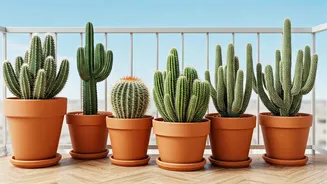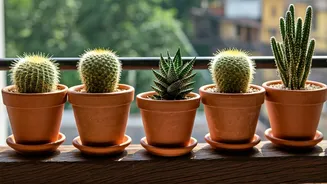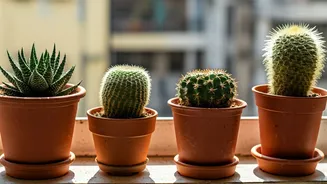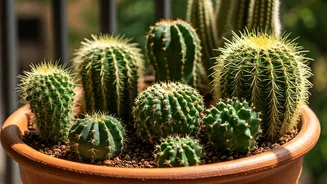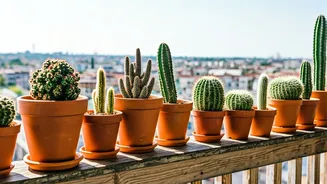Introduction to Cacti
Cacti, known for their ability to thrive in harsh environments, are increasingly popular among gardening enthusiasts. Their adaptability and low-maintenance
nature make them perfect for indoor and balcony gardens, especially in India. These plants offer a variety of shapes, sizes, and even blooms, bringing a unique aesthetic appeal to any space. The beauty of cacti lies in their resilience and ability to store water, requiring infrequent watering and less attention compared to other plants. Furthermore, cacti provide a fascinating glimpse into the world of desert flora, allowing you to create a miniature arid landscape on your balcony. With the right selection, these plants can offer year-round interest and joy, whether you're a seasoned gardener or a beginner. They are a practical yet stylish choice, capable of withstanding the Indian climate. In addition to aesthetic value, cacti often have air-purifying qualities, adding to their appeal. Selecting the appropriate cactus varieties tailored for balcony environments is key to successful cultivation. The ease of care and diverse selection make them an ideal choice for both seasoned gardeners and beginners looking to beautify their homes.
The 'Moon Cactus'
The 'Moon Cactus', also known as Gymnocalycium mihanovichii, is a striking plant that is often grafted onto another cactus species. This grafting process creates a vibrant display of colors, usually including shades of red, orange, and yellow. The Moon Cactus is visually appealing and offers a burst of color, making it an excellent choice for a balcony. It’s important to note, the top part of the moon cactus is unable to photosynthesize. Therefore, it requires the base cactus for survival. They also don't demand much, thriving in bright, indirect sunlight. Proper care involves watering sparingly, allowing the soil to dry out between waterings. The unique appearance of the moon cactus makes it a focal point in any balcony garden. The striking colors and contrasting textures of the Moon Cactus can bring a unique appeal to your balcony. These plants require bright, indirect light, so positioning them in a location that provides protection from direct sun during the hottest part of the day is recommended. Ensuring the soil drains adequately is important to prevent root rot. Its exotic appearance and manageable care requirements make it a favorite for balcony settings.
Barrel Cactus Variety
Barrel cacti (Echinocactus and Ferocactus species) are another excellent option, known for their cylindrical shape and imposing presence. These cacti can grow to significant sizes over time, adding a sense of maturity to your balcony garden. Their architectural form provides visual interest, enhancing the space. Barrel cacti need well-draining soil and plenty of sunlight, ideally several hours of direct sunlight per day. Watering should be done sparingly, only when the soil feels completely dry. These cacti are particularly drought-tolerant, making them easy to manage in a balcony setting. Barrel cacti are slow-growing, providing a long-term gardening investment. They also provide lovely, small, yellow blooms. They are relatively low-maintenance, requiring only occasional care. Their distinctive shape and size bring a unique element to a balcony garden, making them a lasting attraction.
The 'Star Cactus'
The 'Star Cactus' (Astrophytum asterias) is another captivating choice, celebrated for its unique star-shaped form. These cacti are generally small, making them suitable for containers. They don't take up too much space on your balcony. This makes them ideal for smaller balconies or container gardens. Their low-growing habit means they won't outgrow the space quickly. They also produce beautiful, vibrant flowers. These cacti require bright, indirect sunlight and well-draining soil, thriving in conditions that mimic their natural desert habitat. They are very rewarding for their distinct form. Proper care includes watering infrequently. The star cactus's compact size and distinct shape make it a standout choice for anyone looking to incorporate a unique element into their balcony garden. The star cactus is known for its beautiful, intricate structure and compact size, making it a great addition to your balcony garden.
Bunny Ear Cactus
The Bunny Ear Cactus (Opuntia microdasys) is instantly recognizable with its adorable, ear-like pads covered in tiny glochids (small barbed hairs). This cactus is a popular choice for balconies because of its distinctive appearance and manageable size. Although the pads resemble rabbit ears, it's essential to handle them with care as the glochids can be irritating to the skin. This cactus prefers full sun and well-draining soil and can tolerate a variety of conditions. Watering should be infrequent, only when the soil is completely dry. Be mindful of their glochids when handling them, and remember to place this cactus in a location that receives ample sunlight. It is an ideal plant for adding a touch of whimsy and visual appeal to any outdoor space. Its easy care and distinctive look make it a favorite for balcony gardens.
The 'Old Lady' Cactus
The 'Old Lady' Cactus (Mammillaria hahniana) is celebrated for its fluffy, white, woolly appearance. It produces small, colorful flowers, which contrast beautifully with its fuzzy exterior. These cacti are relatively low-maintenance, thriving in bright light and well-draining soil, making them well-suited for balcony cultivation. Watering should be done sparingly. The Old Lady Cactus is a lovely addition to any balcony setting. This species requires minimal care, and its distinctive appearance makes it stand out. This cactus adds a touch of charm and elegance to your outdoor garden. It’s also known for its clusters of vibrant blooms. Its attractive appearance and low upkeep make it a great choice for balcony gardeners. The white woolly covering not only adds to its visual appeal but also helps protect the plant from harsh sunlight.
Tips for Success
To successfully grow cacti on your balcony, a few key practices are essential. First, always use well-draining soil, such as a cactus mix, to prevent root rot. Secondly, choose containers with drainage holes to avoid waterlogging. Place the cacti in a location that receives adequate sunlight, which can vary depending on the species. Lastly, water sparingly, allowing the soil to dry completely between waterings. These plants are drought-tolerant, so overwatering is a common mistake to avoid. Cacti thrive on neglect. Regular inspection for pests and diseases is essential. By following these guidelines, you can create a thriving, beautiful balcony garden. Selecting the appropriate cactus species, providing the right conditions, and handling them with care ensure a successful and rewarding gardening experience. Make sure to choose containers that are appropriate for the size and type of cactus. By adopting these strategies, you’re on the right path to cultivating healthy, beautiful cacti.
